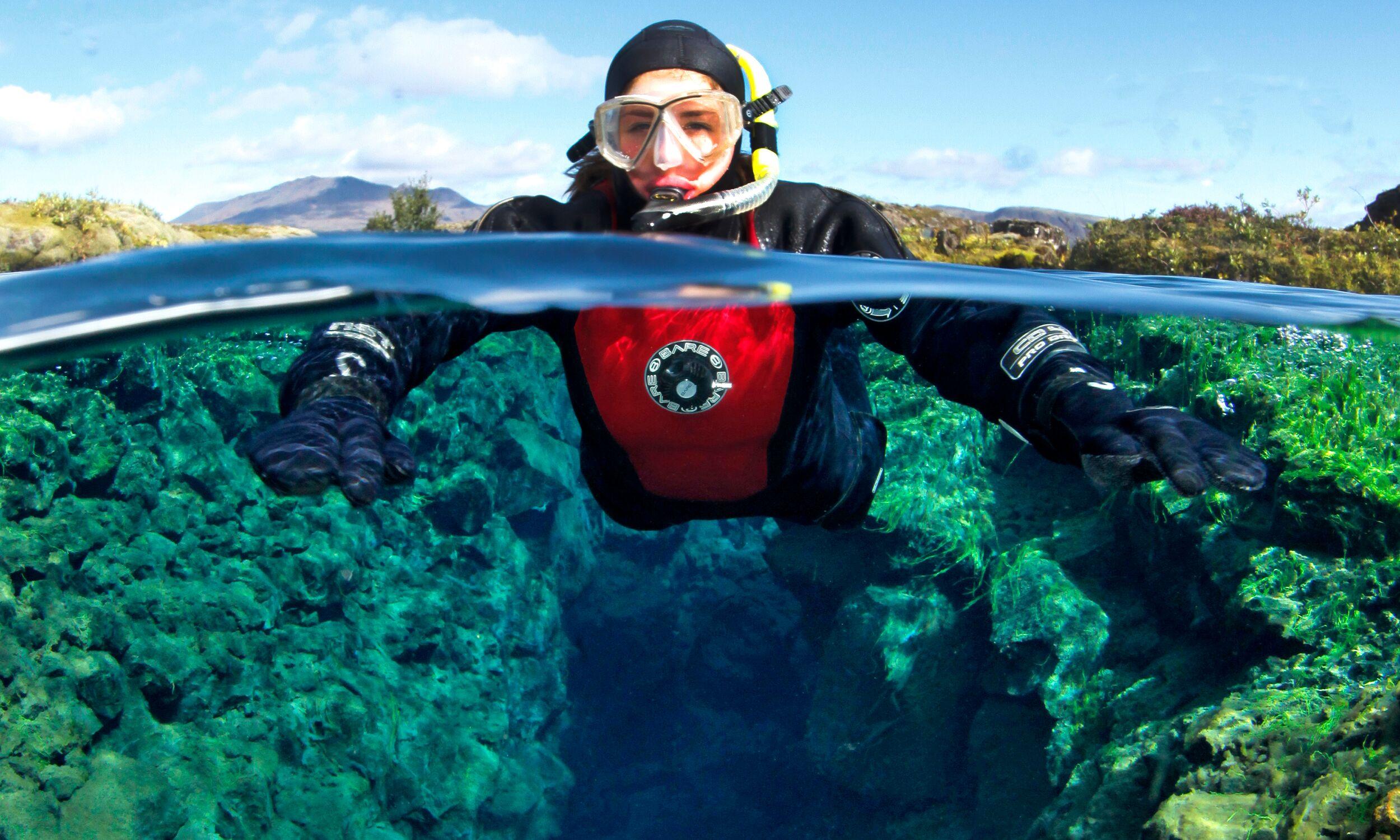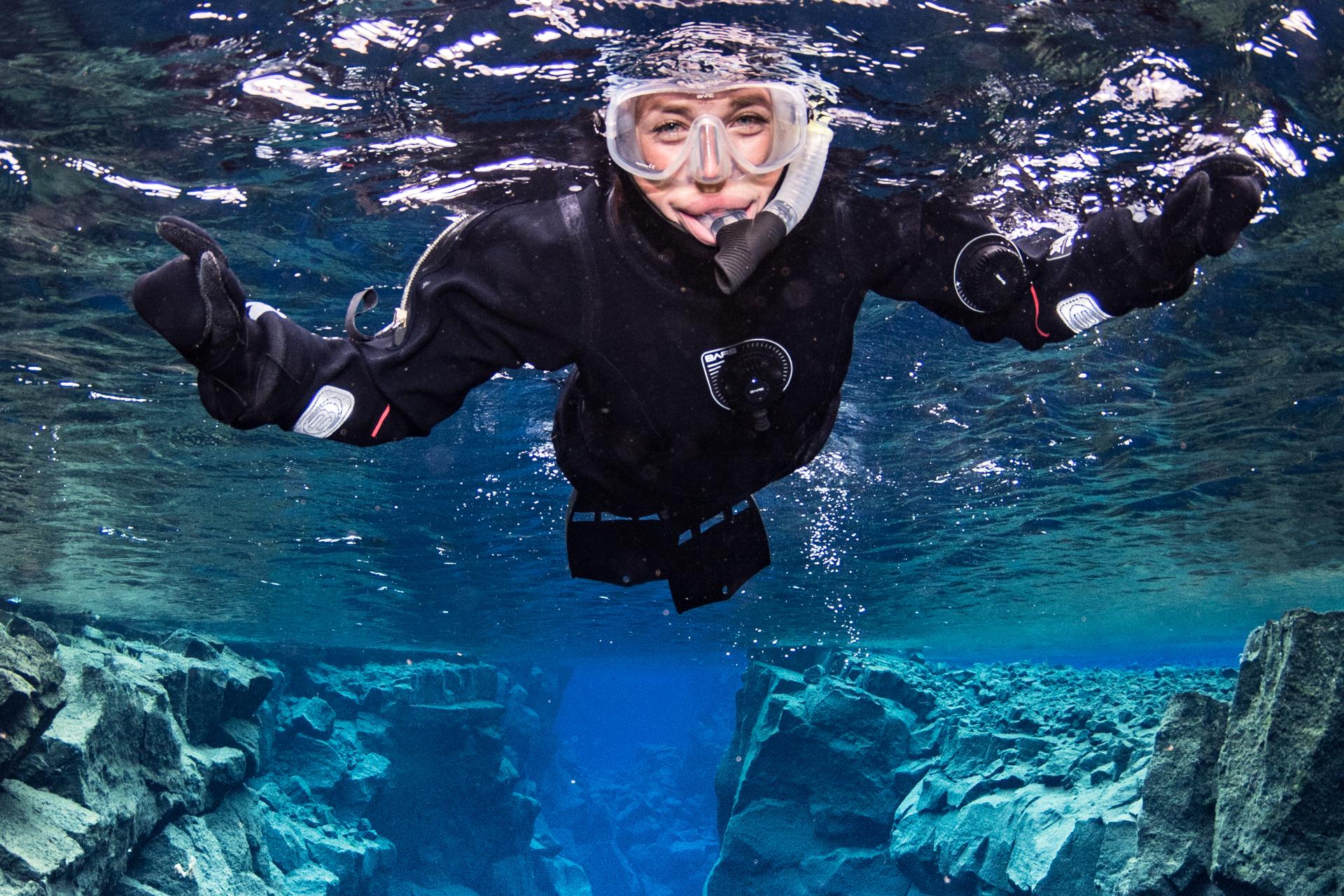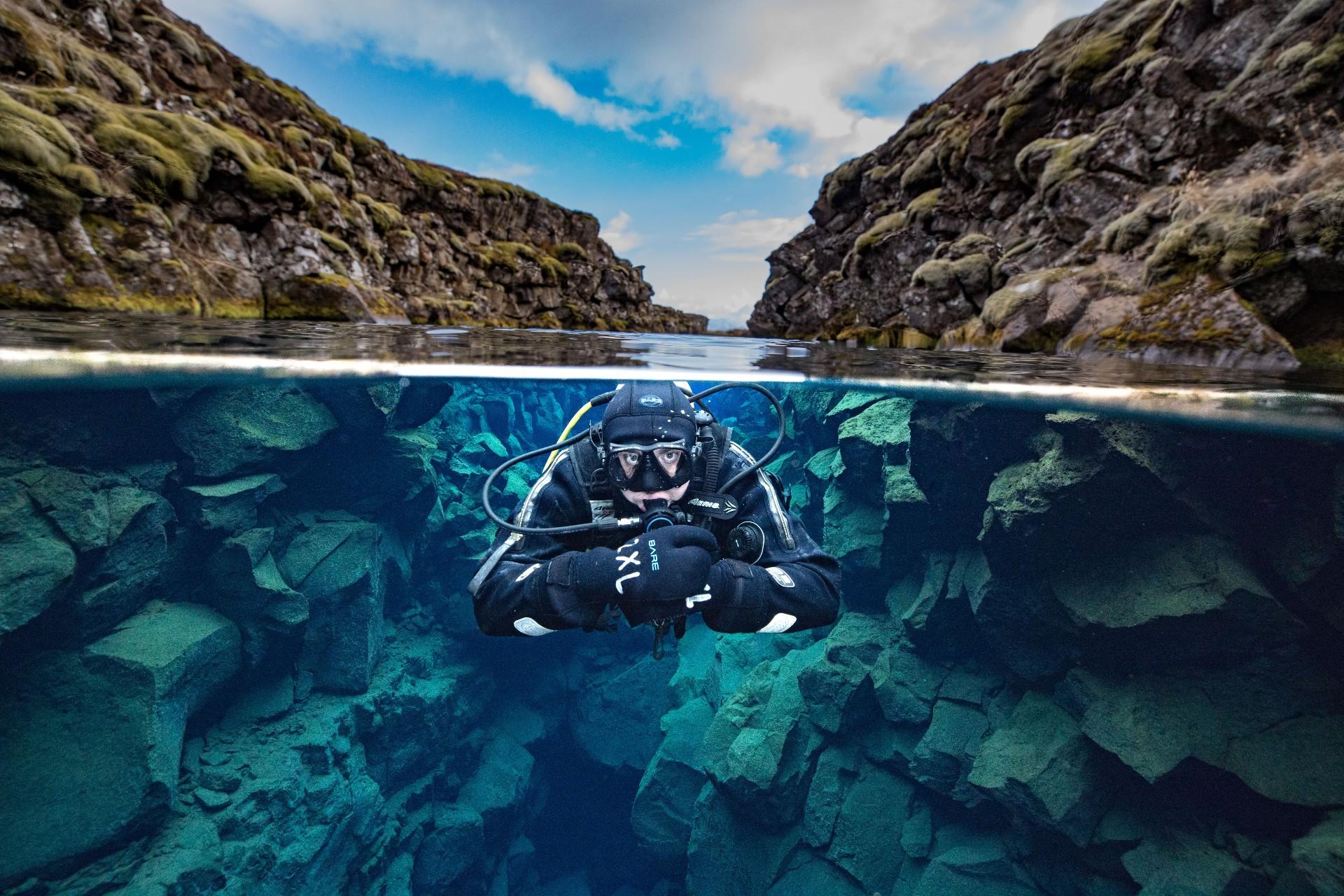
Dive or Snorkel the Silfra fissure
Swimming Between the Continents at Silfra
The Silfra fissure is not actually an ancient sight – the chasm was created in 1789 when an earthquake shook the island as the North American and Eurasian plates moved apart. The first thing that strikes most people visiting the Silfra fissure is how clear the water is.
Visibility can be beyond 100 metres under the surface here as the water is melted ice from the Langjökull glacier, filtered between 30 and 100 years through porous volcanic rock.
By the time the water reaches the Silfra fissure, it is free from impurities, making it crystal clear. You can even drink the water as you dive or snorkel. It is worth bearing in mind that the water is very cold. The Silfra temperature sits between 2 and 4°C (between 35°F and 39°F).
There is lots of life in the Silfra fissure, but it is mostly plant life and microscopic creatures invisible to the human eye. In Þingvallavatn lake to the north of the fissure, there are three types of fish species.
You’ll find brown trout, sticklebacks and Arctic char in the lake. However, the fissure itself is only home to one kind of fish – the dwarf char – which is notoriously difficult to spot, so you may not see any fish during your diving or snorkelling session.
Arctic char might venture into the fissure during mating season, but this is only in July and August.
The sections of the Silfra fissure
The entire fissure is about 600 metres long, and Silfra is divided into three distinctive sections. Most diving tours to Silfra focus on the main section – the cathedral.
You can see the entire distance of this 100-metre (330-foot) chasm and it is called the cathedral because vast lava walls dropping straight down to the chasm’s floor create the feeling of being in a huge cathedral hall. At its deepest point, the cathedral drops to a depth of 20 metres. This is the section of Silfra that most visitors remember long after their snorkelling or diving session has ended.
Silfra hall is smaller than the cathedral, and leads to the Silfra cave systems. These cave systems are lesser-explored and do not feature on Silfra diving tours because they are too dangerous with long swim-through tunnels and narrow passages. Only a few incredibly experienced divers have explored the Silfra cave system.
The Silfra lagoon is another popular spot on Silfra diving and snorkelling tours. This is where the water’s clarity is really demonstrated as you can see from one end of the lagoon to the other – a distance of 120 metres (394 feet). From the lagoon, most snorkelers and divers exit Silfra to make the short hike back to the car park.
Activities at Silfra
Silfra offers a unique experience – the ability to swim between two continental plates. Those that visit Silfra can either take a snorkelling or a diving tour of the crystal-clear water in the underwater crevasse.
Snorkelling tours do not require any prior certification or experience, but Silfra is an extreme environment, so you must go with a guide on an organised excursion where you’ll be equipped with a dry suit and all the necessary bits and pieces to breathe with your head underwater.
Tour organisers require a confident level of swimming from those that embark on a snorkelling adventure because the water is so cold it sometimes leads to people panicking.
For the fully-immersive experience, those with the PADI qualification and dry suit experience can join a guided diving session at Silfra. It is worth noting that participants need to have a logged dry suit dive within the last two years or have completed 10 logged dry suit dives overall to be permitted onto a Silfra diving experience.
While diving and snorkelling are a popular way to see the point where the continental plates meet, you can also simply visit for the view. Within Þingvellir National Park, you can park at Silfra and walk to the water’s edge just to look at the water cutting through the mossy ravine.
Sights and attractions around Silfra
The area around Silfra holds protected national park status. There are lots of walking trails and hikes around Þingvellir National Park, including a walk between the tectonic plates on land where seismic activity has created stacks of rocks.
Along this route, you’ll also find the spot of Iceland’s (and one of the world’s) first parliament – the Alþingi – now marked by a flag. One of the most popular past-times in Iceland is chasing waterfalls and you can do this at Þingvellir National Park by following the Öxarárfoss Waterfall Trail. It is an easy 2.1-kilometre trail that takes you along the Öxará River and past the pretty little church within the national park.
Silfra sits along the famous Golden Circle route, so a visit here can be combined with Iceland’s other natural wonders like Gullfoss waterfall and Geysir area of geothermal activity. There are a few Golden Circle tours that combine a visit to Silfra and Þingvellir National Park with the rest of the route’s highlights.
All About Silfra Iceland
You’ll find the Silfra fissure within Þingvellir National Park, in the southwest of Iceland. It marks the point where the two tectonic plates of North America and Eurasia meet.
Silfra is relatively close to Iceland’s capital. It is 60 kilometres from Reykjavík to Silfra and the drive usually takes between 45 and 55 minutes. There is no public transport directly to Silfra, so the best way to get here from Reykjavík is by driving yourself or joining an organised tour.
While the biggest Silfra depth is 63 metres (around 207 feet), the furthest you are permitted to dive beneath the surface is 18 metres (which is the standard limitation for most PADI-qualified divers anyway). Most Silfra tours don’t descend deeper than 10 metres (32 feet).
One of the most striking things about diving at Silfra is the diamond clarity of the water. You can see beyond 100 metres in front of you – exceptional visibility.
The water is so clear because it takes between 30 and 100 years of filtration through porous volcanic rock to reach the surface. By the time it reaches the chasm, the water is extremely pure.
If you are happy to meet on location at Þingvellir National Park, a diving experience at Silfra costs around $250. As we have mentioned, getting to Silfra can be tricky so you can add transfers from Reykjavík for a total of $300 for your Iceland tectonic plates diving experience.
Snorkelling in Silfra requires less equipment so is the cheaper way to explore the waters between the continental plates. Meeting on location, a snorkelling session in the crystal-clear chasm between the continents costs around $140 and with pick-up from Reykjavík, it is around $200.
You can also combine a snorkelling session in the ice-cold water of Silfra with a luxurious soak in a geothermal bath for around $175 (self-drive).
Although it is not the only tectonic fissure you can visit in Iceland, Silfra’s crystal-clear water and beautiful rock formations makes it the most unique.
Many positive Silfra reviews rave about the experience and show that the experience is definitely worth it. You probably won’t see any marine life, but the high visibility shows off the rocks and interesting plant life that looks like it is from another planet.
While there is plenty of life in Silfra, most of it is invisible to the human eye – unless you’re talking about plant life, of course. Bright green, twisting “troll hair” grass grows at the bottom of the chasm and there are loads of unseen microscopic invertebrates.
There are three types of fish that live in the Þingvallavatn lake that feeds into the Silfra fissure – brown trout, sticklebacks and Arctic char. Only the Arctic char ventures into the fissure and only during mating season in July and August.
The only fish you might spot in the fissure itself is the dwarf char, but these are very small and tend to lurk in hidey holes and dark spots. Spotting a dwarf char is rare.
As long as you go with an organised tour, snorkelling in Silfra is perfectly safe. In fact, an organised, guided session which includes the use of a dry suit, is the only way to experience snorkelling in Silfra.
The dry suit keeps you warm and prevents the risk of hypothermia. The biggest risk to snorkelers in Silfa is the cold as the water is around 2 to 4°C. There is also a risk to those who experience claustrophobia as unexpected panic can set in when you descend into the water. Those that struggle to swim or have low physical fitness should not attempt to snorkel at Silfra.
You cannot snorkel in Silfra without a guide or organised tour due to safety regulations. But you can use your own snorkelling equipment on a Silfra tour if you prefer, just make sure your equipment is serviced and prepared for cold-water exposure. You also need to be able to swim capably to get in the water at Silfra as it is an extreme environment.
You cannot dive in Silfra without an organised tour for safety reasons. Unlike snorkelling in Silfra, you also need to be PADI qualified to dive and be trained in dry suit diving before you arrive with at least one dry suit dive logged in the last two years or 10 dry suit dives logged overall.
There are many single-day dry suit courses on offer in the UK and US to prepare for your visit if you aren’t already qualified.
Silfra is not for young children as the minimum age to snorkel here is 12 years old and participants must be at least 17 years old to dive at Silfra. 17-year-olds diving need a signature from their legal guardian to participate in the experience.
If you are over the age of 60, you need to have a diving medical statement signed off by a doctor to dive at Silfra.
Related tours

Thingvellir National Park & Silfra Transfer
The Þingvellir and Silfra transfer service takes you to one of Iceland's most iconic sites. It's ideal for those needing transportation for their snorkelling or diving tour at Silfra, and those wishing to explore Þingvellir National Park independently.

Snorkelling Silfra Tour with Pick up from Reykjavík
Experience snorkeling in Silfra, with return transfers from Reykjavík. Float between continents in the clearest glacial waters on Earth with 100m visibility.

Snorkelling Silfra
Snorkel between the North American and Eurasian continental plates in this once-in-a-lifetime experience. The Silfra fissure in Þingvellir National Park is filled with glacial water that has been seeping through underground lava rocks for decades producing the clearest water on earth. The fissure allows for over 100 metres of visibility.

Diving Silfra Tour - Self-drive
Dive between the North American and Eurasian continental plates in this once-in-a-lifetime experience. The Silfra fissure in Þingvellir National Park fills with glacial water that has been seeping through underground lava rocks for decades producing the most transparent water on earth. The fissure allows for over 100 metres of visibility. This tour is a fantastic way not just to see Iceland but to get in the water and experience it.

Diving Silfra Tour with Pick Up
The Diving Silfra Day Tour takes you into one of the most remarkable dive sites on the planet. Silfra is a natural fissure created by the slow separation of the North American and Eurasian tectonic plates. Here, you descend into glacial meltwater renowned for its extreme clarity, offering visibility that can exceed 100 meters. The water you dive in has travelled for decades through porous volcanic lava, acting as a natural filtration system and creating an underwater environment unlike anything else on Earth. The result is a surreal, light-filled landscape found nowhere else in the world.

Hot and Cold Snorkelling and Spa tour - Self-drive
Snorkel between the North American and Eurasian continental plates in this once-in-a-lifetime experience. The Silfra fissure in Þingvellir National Park fills with glacial water that has been seeping through underground lava rocks for decades producing the most transparent water on earth. After snorkelling, drive your rental car to the heavenly Laugarvatn Fontana spa to warm up and relax!

